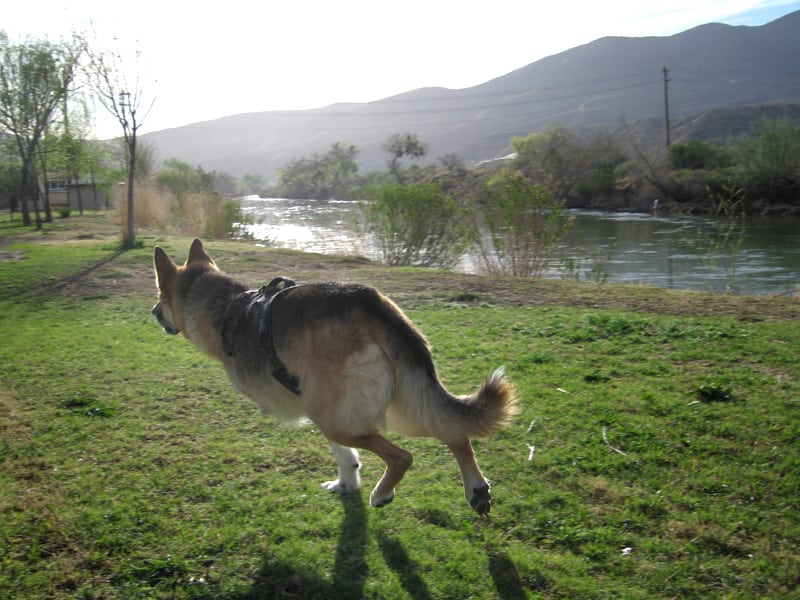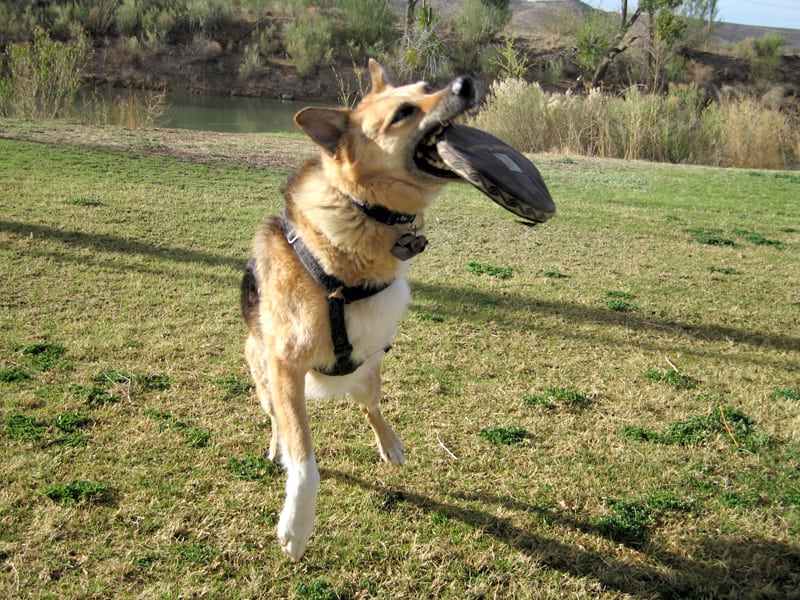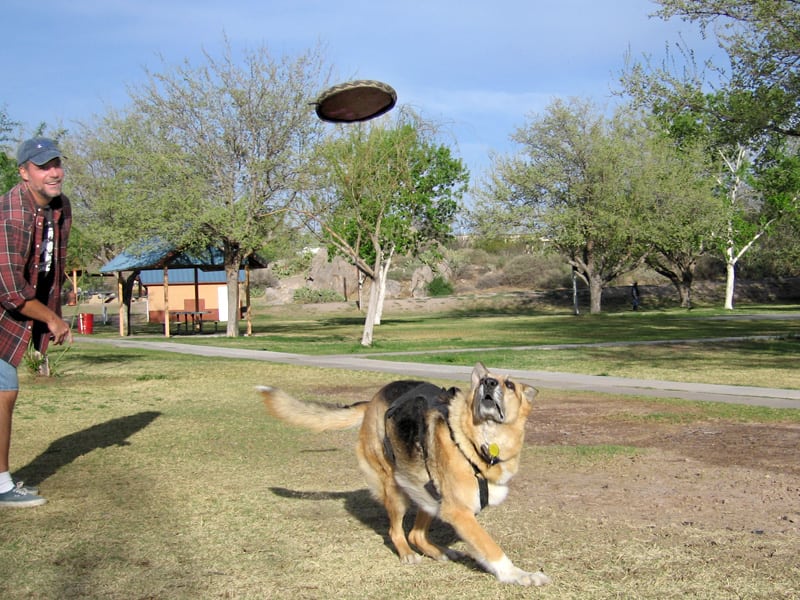Did you ever do something for your Tripawd that you ended up regretting? We did. You see when Jerry came home from amputation surgery, we wanted him to just enjoy life and have fun again. Even his vet told us to let him get back normal. Jerry did and life was great again! Unfortunately we didn’t know about these Tripawd health tips to avoid injury. Here’s what happened.

Tripawd Health Tips to Avoid Injury
Nothing was better than watching Jerry run after a ball, go on longer walks or play his favorite game, basketball. Today we cringe when we watch this video (we are embarrassed to show it to you). At the time we thought we were being safe by only letting him play on grass.
We slightly modified our play times by throwing balls and Frisbees a bit lower. Our hikes were shorter too. We thought we were being smart. But our enthusiasm to let him get back to “normal” was silently harming him. Here he is playing on the banks of the Rio Grande River in New Mexico.

See how all of his legs are off the ground? Not good. Eventually one of Jerry’s rear legs gave out during a Frisbee session. Carrying him home was terrifying.

We never want anyone to go through what we did during that time. Thankfully someone told us about how acupuncture helps pets. After Jerry recovered we vowed to avoid the same mistakes (and keep others from doing the same).
What You Need to Know About “Getting Back to Normal”
Deciding on the right type and length of activity for any Tripawd is a balancing act. You’ll constantly learn from your mistakes, but here’s how you can minimize the impact. After our many talks with orthopedic surgeons and veterinary rehab therapist visits we know understand that:
Recovery doesn’t end when stitches come out.
A new amputee needs more time than you think to get their spark back. When stitches come out, it’s time to celebrate but also begin safe exercises for Tripawds. Restart any activity slowly and with caution. Better yet, take your Tripawd to a licensed veterinary rehabilitation therapist (the Tripawds Foundation may pay for your first rehab visit!).
All recoveries are different. Don’t compare your pet’s progress to another’s.
Healing doesn’t happen on a pre-determined timeline. Go slow with activity and watch your dog or cat carefully for signs of fatigue. Never allow your new amputee to run freely without requiring breaks and rest. And remember, if your animal lays or sits down in the middle of a walk or play session, you’ve allowed them to do too much too soon.
Repeated stumbles and face plants are not normal.
All new Tripawds will have an occasional stumble, face plant or fall immediately post-op. But if these things continue, that’s your clue to slow things down. Ask yourself: are you throwing a ball too far? Letting your Tripawd play too long?
Jerry had more than one stumble during his first few weeks as a Tripawd. We figured that was normal. But his face plants were our fault. We let him do too much too soon, without building up his core muscles. Today we know that good core strength helps Tripawds avoid falls.
Happy YouTube Tripawd videos are fun to watch, but they don’t tell the whole story. You don’t know if that Tripawd paid a high price for all that fun. Here’s another video of happy Jerry playing Frisbee before his leg gave out. We can’t believe we allowed this to happen. Yes, it was fun but he paid the price and to this day we feel bad that we didn’t know any better.
Whether you have a new Tripawd or a pet who’s been on three-legs for many years, please check out these helpful Tripawd health tips to avoid injury on remaining legs.
Loving Life on Three Legs: Canine Fitness and Conditioning for Happy, Healthy Tripawds
DIY Core Strengthening Exercises for Cats
Learn Rehab and Fitness Tips for Tripawd Cats and Dogs, Part 1
Fun Tricks and Tips for Bonding with Cats and Dogs
Learn How to Manage Your Dog’s Pain with Dr. Petty’s New Guide
Hello, any suggestions on how to manage a 12.5 year old yorkie that always sleeps with us in our high bed? He’s getting his front leg amputated on 7/7/22. After recovery I’m worried he’ll jump off the bed and injure his remaining front leg. He always uses stairs we got for him to get on the bed but never to get down, even after trying to train him to do so before hand we had no luck. We’ve had 50/50 success with him jumping down on an ottoman to reduce the distance/impact of the full landing, but not sure if he’ll keep that up. Also, considering our rooms layout, a ramp would not work. Having him no longer sleep with us seems unrealistic and cruel so not sure if that’s an option so any suggestions are immensely appreciated. Thank you.
Hi Mike, great question! Consider posting in Hopping Around so you can get feedback from others besides us. About the only thing we can think of is to put your bed on the floor, or at least have a big cushioned area below the bed where he tends to jump down so that you can break his landing. This is a tough situation nobody ever expects to be in when their dog starts sleeping on the bed. So sorry you are going through this. Let us know how else we can help.
Hi Jerry,
Thanks for your response.
Would you say he’ll most likely injury himself otherwise (guessing yes)? This one is a biggie and the hardest to cover. Already put the baby gates back up, more rugs, stair rugs, etc. Just need to get this one covered! Already thought of putting the bed on the floor, but we’re trying to avoid that if we can.
Thanks,
Mike
Question about prevention. I have a young dog, front leg amputee, who is very active/athletic. Is it possible to use support wraps on her one front leg? This is common with performance horses and I hope that I can fashion something similar for my tripod pup.
Hi Ann. Great question. We are not vets, but we have never heard of this as an option. In fact, rehab vets tell us that any kind of support device placed on a Tripawd without the supervision of a vet therapist can do more harm than good. Please consider taking advantage of our Tripawds Rehab Reimbursement program so your pup can get evaluated by a therapist and you can learn how to keep him safe.
Do you let your tripawd jump out of the car by himself? I always worry that it’s too much stress on the one remaining front leg by my three legged golden retriever wants no part of me helping him out.
No, we would never allow that, nor to jump up in, regardless of which leg is missing. Such high impact on single remaining limbs will cause damage over time, and can cause immediate injury. Use a harness to help your dog down. Use positive reinforcement and whatever training methods which work for your dog.
My dog Koko fell in our house trying to run to the front door when someone rang the bell. She somehow flipped and fell. It’s been 2 wks and recovery is slow. She had major muscle spasms in her back. She needed meloxicam, gabapentiin and now 4+ treatments with acupuncture. She cries in pain and I run for GABA. Many many sleepless nights fur both of us. So it’s not only anything deliberate like throwing a ball but something as simple as hearing the doorbell and falling while trying to race the human! She is strong though and will pull through. Keeping her spirits up is important because they in their minds have 4 legs!
Best wishes to Koko in recovery! So sorry about the accident. If you have any questions about life on three legs come visit us in the Triapwds Discussion Forums.
Perhaps the Tripaw website should feature more rehab and core strengthening photos with dogs and some less photos of tripaws racing around frociling at top speed? It is great to send the message that tripaws can live a good life – but a single blog that gives caution for rehab and strengthening will not have the kind of impression that the day to day photos of dogs racing around does. My oldest border collie and tripaw passed away last june. For the last two months shewas in a happy tails walker. But she was continuously, for the 18 months post amputation, on a regular regimen of K9conditioning exercises. And we did constantly moderate her activity level. Border collies, left to their own devices, will run/play/wrk themselves into the ground. She for sure had plenty of fun! But it was in frequent, but shorter duration sessions. And liberally sprinkled with swimming, message, adjustments, core conditioning. The vets community, generally, does not communicate well about the need to rehab pets. Post surgery and with a a few wks of recovery – “can return to normal activity”. That does not mean they should. Post op of any type and even with just 2-3 weeks of low/no activity, a dog loses muscle strength, mass, and stamina. It is fine to say vets should be better informed – so should we guardians. We are their health care advocates:-). Good blog!
Hi Toni! It’s nice to meet you, thanks for commenting and sharing your story. Your girl had a great life, what a lucky dog to have a mom like you! We would love to hear more about your dog. Please consider writing a guest blog post about your experience, it’s always beneficial for others to hear how rehab therapy has helped their Tripawd. Contact us if you’re interested.
Meanwhile, I hope you (and everyone who joins the community) will check out our many resources about keeping Tripawds safe from injury through rehabilitation and conditioning. With nearly a decade of continuing this important discussion, we’ve compiled an incredible library of information. From exploring the benefits of rehab therapy, to core-strengthening tips, our interviews with orthopedic and rehab veterinarians and pain management experts, the many member-contributed blogs about rehab therapy and our e-book Loving Life on Three Legs, and so much more. It’s our #1 goal to never repeat the mistakes we made with our Jerry and help our wonderful members do the same.
We’re glad you enjoyed this post! Thanks.
Very good blog guys!!! Hey, we all make mistakes…but we learn from them as you did with Jerry! Thank you for sharing your story and what you learned to do and not do! Hopefully, the vets community is getting more informed now on what to tell clients to do with their tripawds now.
Tracy & Spirit Maggie
Thanks Tracy, I know you totally get it. I still beat myself up over our ignorance, but you don’t know what you don’t know right? Well, thanks to you you and your pawesome contributions here, we’ll never make those mistakes again. Thank you a million times from all of us.